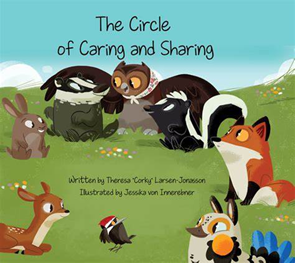
How can your sharing stick represent who you are and where you came from?
In a Grades 1 to 3 classroom, the teacher read the book The Circle of Caring and Sharing by Theresa Larsen-Jonasson. When two foxes who are best friends have a fight, it upsets the whole community of animals. Kokom the Owl knew just what to do and brought together all the animals and held a Sharing Circle. After reading the book, the teacher then led a discussion about how sometimes friends disagree with each other and need to come together to solve their friendship problems.
The teacher next took the learners outside on a community walk to gather sticks so that they could create their own sharing sticks. Before the community walk, the teacher explained that when learners were looking for sticks, they needed to make sure that the sticks were already on the ground and not part of a living tree. The teacher used this opportunity to discuss with their learners many Indigenous ways of knowing, being, and doing related to honouring and respecting Mother Earth.
Learners looked carefully for sticks that were interesting, unusual, or that they felt drawn to. They gathered up to five sticks during the walk. As learners gathered them, they were instructed to think about the wonderings they had about their sticks: What kind of tree did it come from? How long has the stick been on the ground for? Who else might have picked up this stick in the past?
Before the learners left, they gathered in a circle on the ground to honour the land that they were learning from. Learners also placed their sticks on the ground in front of them and then chose one of them to talk about. They could share why they chose that specific stick versus the other ones they gathered or discuss what they liked about the stick. Learners were encouraged to use describing words when sharing their stick. Then, they gathered their sticks and walked back to school where they were all placed into one large container.
On the second day, the teacher laid out the sticks around the room and learners had to choose one that would eventually become their sharing stick. They gathered on the carpet, where they shared if their stick was the same stick from yesterday or if they discovered a new sharing stick. The teacher then used the sticks to inspire some math lessons on estimation and non-standard and standard measurement. Learners estimated the length of the sticks using a variety of non-standard objects (e.g., Unifix cubes, paper clips, pencils) and then measured them using those objects. Some learners estimated/measured using standard measurements.
On the third day, the teacher introduced a variety of materials that the learners would use to create their own individual and personalized sharing stick (such as ribbon, leather strips, shells, feathers, stones, yarn). Learners had to then design their sharing stick by drawing on the stick and adding the materials they would use to help show others how this stick represented themselves. The teacher gave some suggestions as to what might be included on their sticks: the number of siblings in their family, number of pets, their age, their culture, favourite objects, and so on. Learners completed their design by drawing and labelling the objects and then met with a peer to share how their stick would represent their individuality. Peers offered feedback on the design, and learners went back to their design and made modifications based on the feedback.
Learners then began the process of creating their sharing sticks. The teacher modelled how to adhere objects to their sticks so that they would stay on. When all learners finished their sharing sticks, they were placed somewhere they could be displayed so all could see. The teacher used this opportunity for an art talk where learners could point out one specific stick that they wanted to talk about. The teacher used the technique of placing numbers beside the sticks and not their names so that the learners would refer to “stick number seven” and not “Billy’s stick.” The teacher then had a few learners share their sticks each day so that the attention would be on only a few at a time. The learners were encouraged to ask relevant questions related to the objects the learners added to their sharing sticks. The teacher modelled how to ask questions that would help everyone in the class to know more about each individual learner. After each learner shared, the teacher asked the learners the following questions: What did we learn about this learner? What makes this learner unique and needs to be celebrated? What were you surprised to discover about this learner? The experience helped the learners really get to know each other as individuals and to build community.
Teachers may also want to refer to the book A Walking Curriculum: Evoking Wonder and Developing a Sense of Place (K–12) by Gillian Judson to familiarize themselves with some learning strategies for outdoor experiences.
Judson, Gillian. A Walking Curriculum: Evoking Wonder and Developing a Sense of Place (K–12). Independently published, 2017.
Larsen-Jonasson, Theresa “Corky.” The Circle of Caring and Sharing, illustrated by Jessika von Innerebner, Medicine Wheel Publishing, 2023.